Hack 8. Take Your PSP Apart  
This hack is a step-by-step guide on how to take your PSP apart, from top to bottom, from case to wireless network card. There may come a point in time where you will need to take apart your PSP. For example, your keypad may stop working, or perhaps you will need to remove a stuck Memory Stick. Regardless of the reason, this hack will provide you with the blueprints needed to successfully take your PSP apart. And yes, before we go any further, my PSP still worked even after it was spread out, exposed, and naked before me on my work desk. I realize many of the readers will want to jump right in and start dismantling their device, but please heed the words of warning spread throughout this hack. Too much enthusiasm is not a good thing when dealing with electronics. A steady hand and some patience can go a long way when dealing with tiny and fragile components. That said: please do not feel threatened. Even the most inexperienced "hacker" can accomplish this hack. Just follow the instructions, and all should go right! For your convenience, the disassembly process has been broken down into several different sections. 1.9.1. The Tools of the Trade In order to take your PSP apart, I recommend that you have the following supplies on hand. You do not have to use them all, but things can go much more smoothly with these items available and a few minutes of preparation: Paper for screw placement notes Pen/pencil Small flat head screwdriver Small Phillips head screwdriver Needle nose pliers (handy for picking up dropped screws) Flat and clean white surface (easier to see parts) Digital camera for snapping photos along the way (use these photos to help you remember how it goes back together and to post cool photos on your weblog)
1.9.2. Critical Suggestions In addition, you should also keep these suggestions in mind: Remove the battery when instructed and leave it out when taking apart the PSP. In addition, do not attempt to plug in any power source to the PSP until it is fully reassembled. You can easily kill off large parts of the PSP [Hack #6] by not following this advice. Use extreme care when releasing circuit strip/ribbon catches, since they can easily break. Do not drink or eat around the open PSP. Do not take your PSP apart in a high traffic area. There is nothing like a hyper kid, slobbering pet, or three-foot drop to turn your PSP into a $250 paperweight. Be careful how much dust is in the air. Since your PSP will be apart, it is easy for that dust to cause problems at a later date if it takes up residence inside the device.
1.9.3. Taking the Top Off Prior to beginning, place your PSP and all tools on a clean and clear surface. I recommend you have some sort of mat to provide some comfort for your PSP while its internals are removed. Next, create a few sketches of your PSP on the piece of paper, in order to track where the screws go when trying to put the PSP back together again. Figure 1-23 provides you with an illustration of the first screws that need to be removed. Figure 1-23. Layout of PSP case screws 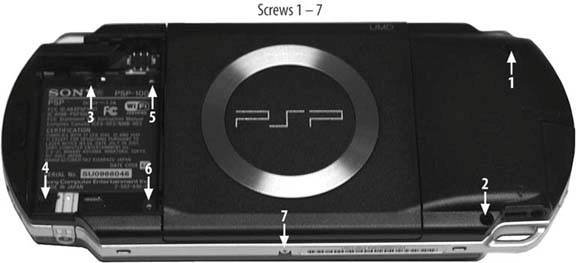
Here's how to take the top off: Remove the battery cover and remove the battery. Take out the Memory Stick. Remove the black screw (1) from the upper-right quadrant, shown in Figure 1-23. Remove the black screw (2) from the lower-right quadrant. Remove the warranty seal from inside the battery cavity (yup, you've just voided the warranty). Remove the black screw (3) from the upper-left quadrant (battery cavity). Remove the black screw (4) from the lower-left quadrant (battery cavity). Remove the silver screw (5) from the battery cavity. Remove the silver screw (6) from the battery cavity. Remove the silver screw (7) from bottom side of PSP. Turn the PSP over and slowly lift the top shell off.
1.9.4. Removing the LCD The next step is to remove the LCD from the PSP. Be careful, as this is arguably the key component to your device and almost certainly the most expensive to replace. A scratch or too much pressure could cause serious problems. Figures 1-24 and 1-25 provide you with illustrations for the following steps: Carefully pry the catch off the left side of the lower button circuit strip with a small flat head screwdriver. Lift the button bar assembly off the PSP. Carefully release the catch to the circuit strip that connects the bar to the PSP. This is accomplished by using a small flat head screw driver to lift the brown catch up, which allows the circuit strip to slide free of the catch. The LCD is held in place by four bevel catches to keep the LCD screen in a metal LCD tray. Carefully slide a flat head screwdriver between the LCD screen and the tray at the top-left corner and lift the LCD screen out of the tray. Once it has freed the catch, do the same on the lower-left side of the LCD tray. Once this side is free, slowly lift the LCD screen up a few millimeters out of the tray and then lift only the top of the LCD screen. There are two circuit strips behind the LCD that need to be removed before taking out the LCD. Lift the left (smaller) catch from the top to release the circuit strip. Lift the right (larger) catch from the bottom to release the larger strip.
 | Getting a feel for releasing the catches takes a little practice. You do not want to break off the plastic catches or break a circuit in the connector. |
|
1.9.5. Removing the LCD Tray The most important part of this stage is that you carefully record where each screw goes. Since most of the screws are different sizes, it would be easy to mix them up. Figure 1-26 illustrates where each of the screws is located.  | Be careful not to strip the screws. It is better to apply pressure to ensure the screwdriver head does not slip than it is to strip the screw. |
|
Figure 1-24. Removing the LCD from tray 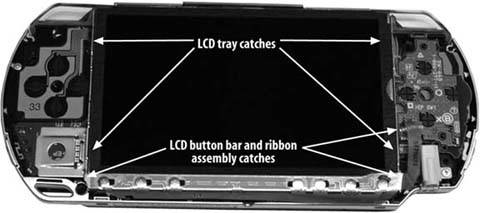
Figure 1-25. LCD circuit ribbon connections 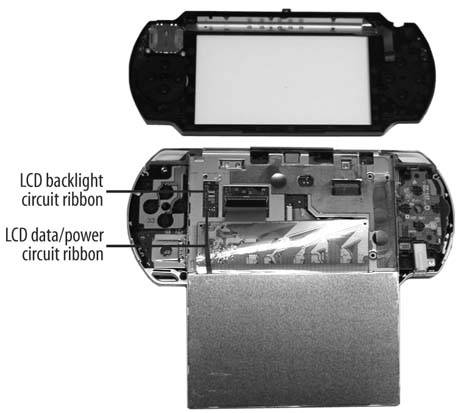
Here's how to remove the LCD tray: Remove the silver screw (8) from top right of tray. Remove the two silver screws (9 & 10) from the top left of the tray. Remove the two silver screws (11 & 13) and one black screw (12) from the lower left of the tray. Eject the UMD disk tray. Lift the tray from the bottom of the PSP and slowly wiggle it loose from the UMD catch at the top of the PSP.
Figure 1-26. LCD tray screw positions 
1.9.6. Removing the Main Circuit Board This part of the disassembly process is the most difficult. The main board is connected via screws, a USB connector, and a circuit connector hidden under the board. In addition, there are wires at the lower end of the board that connect to the speakers and components under the board. You do not have to remove these to get under the board if you simply flip the circuit board over onto its top when it is removed. Figure 1-27 highlights the various points you need to pay attention to when removing this circuit board. Figure 1-27. Screws, latches, catches, and more on the circuit board 
To remove the main circuit board: Unlatch the right controller circuit strip and the UMD drive circuit strip. The controller lifts from the bottom, and the UMD catch requires slight pressure from the left against the black plastic arms. Remove screw 14 from the top right of the circuit board. Remove screw 15 from the left side of the left controller. On the top right of the main circuit board, carefully remove the power connector (white with black wires). This will require you lift the board first before disconnecting the white plastic socket. On the lower side of the left controller, pry up the circuit board over the catch and lift the controller over the top of the PSP. Peel back the tape holding the black power wire and lift the antenna off the main circuit strip, disentangling it from the tape and the right controller. Slowly lift the circuit board up off the PSP by slipping out the USB connector from the top plastic shell, then raising the top of the board and flipping it over the bottom of the PSP. You will need to apply pressure and pry the board off a hidden connector that keeps the board connected to components deeper inside the PSP.
Figure 1-28 highlights the various chips found on the main circuit board. The following list names them and shows the identifying information you'll find on each chip:
Chip 1 -
CXD2962GG ©2004SCEI 507D10E 641711
Chip 2 -
CSD1876 ©2004SCEI-102GG 504A99E 278491
Chip 3 -
SAMSUNG 501 K5E565H8CM-D060
Chip 4 -
SC901583EP MXAEA0423
Chip 5 -
MB44C001 0505 M51 Figure 1-28. PSP chips on the main circuit board 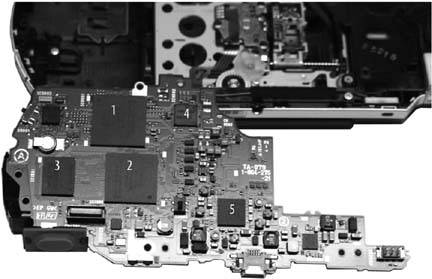
1.9.7. Removing the Wireless Network Card The following requires you to remove several components before you actually get the network card board (SWU-BXJ154N). This part of the removal is layered, so be sure to follow the instructions. Figure 1-29 highlights the significant pieces and Figure 1-30 provides a shot of the network card with antenna and wire. Figure 1-29. Pieces and parts of the lower PSP 
To remove the network card: Remove the silver screw (16) from the top left of the PSP, holding the silver tray onto the device. Remove the silver screw (17) from the bottom left of the PSP, holding a black plastic supporter. Remove the silver screw (18) from the left of the PSP, holding the black plastic supporter. Lift the black plastic piece out and then remove the silver grounding tray. Lift the network/Memory Stick combo circuit board out of the PSP shell.
Figure 1-30. Shot of the network card and antenna 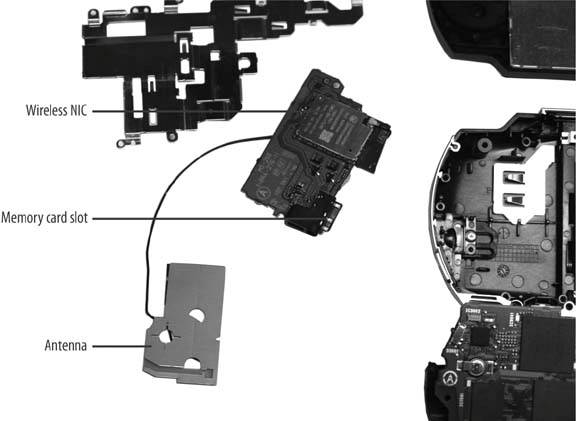
1.9.8. The End Result Figure 1-31 shows the final results of disassembling the PSP. All of the major pieces are out of or at least disconnected from the body. Nothing appears to be broken, which means it is time to put it back together! However, that particular chore is left for "Reassemble Your PSP" [Hack #9]. 1.9.9. Hacking the Hack Now that you know how to take apart the PSP with some semblance of safety and order, you can take your knowledge and put it to use as you find ways to modify the PSP. External antennas, FM receivers, bling-bling, or even just a simple case mod are now easily within your grasp! Seth Fogie Figure 1-31. The completely disassembled PSP 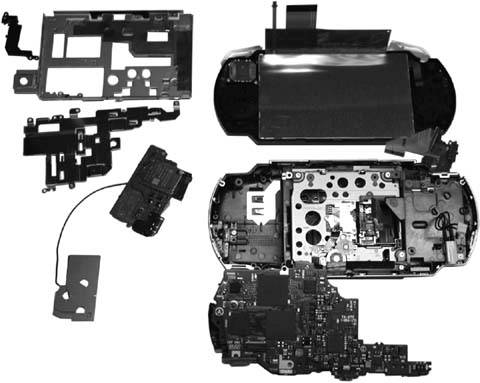
|








